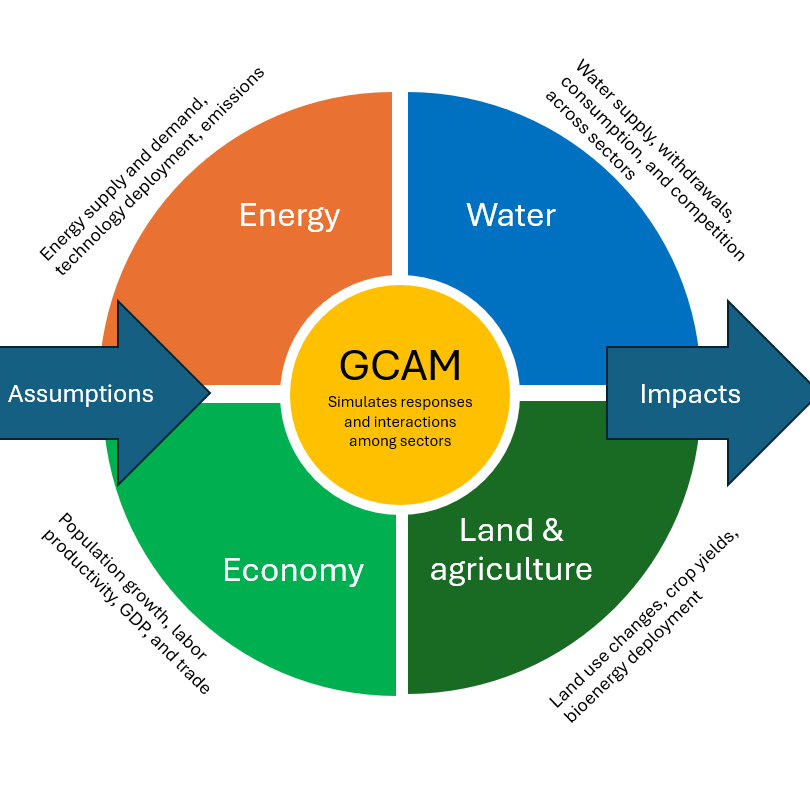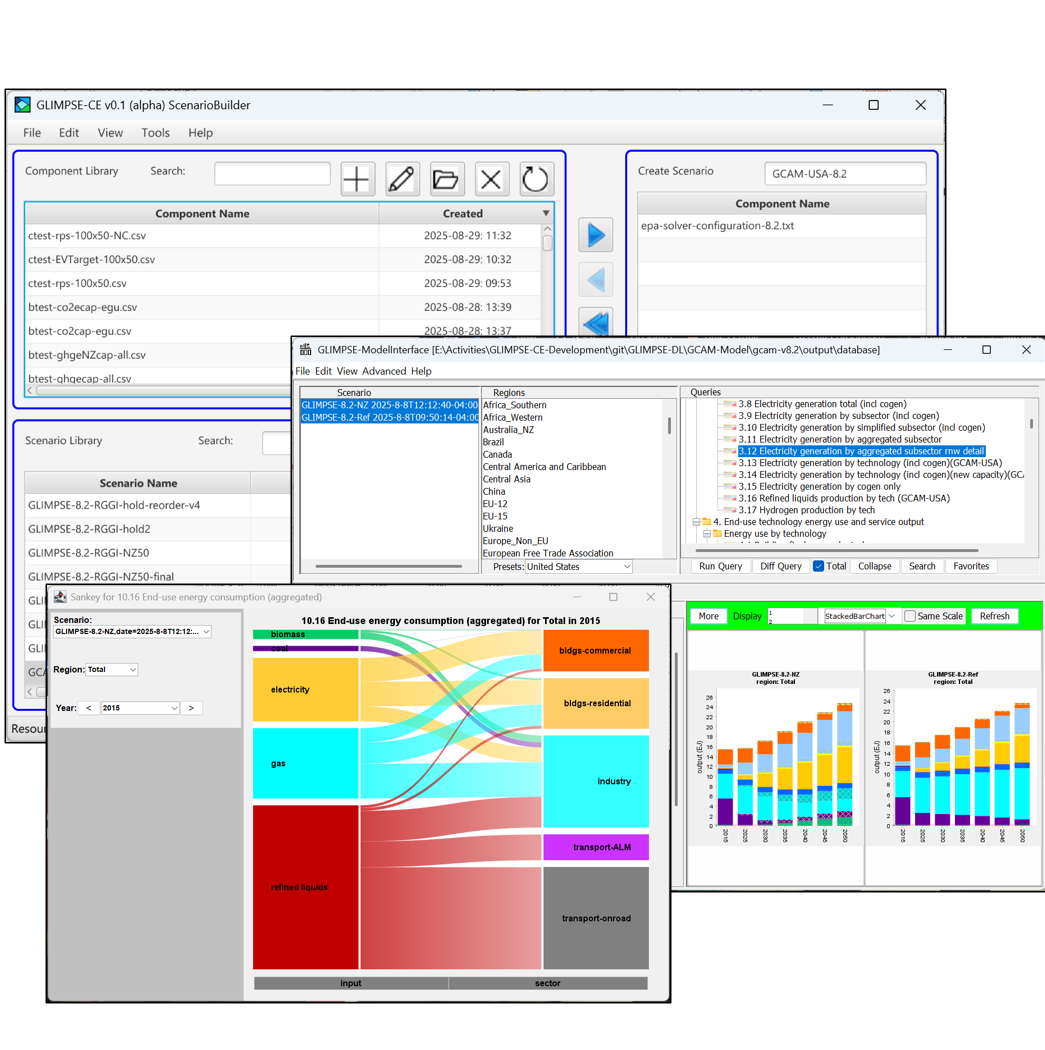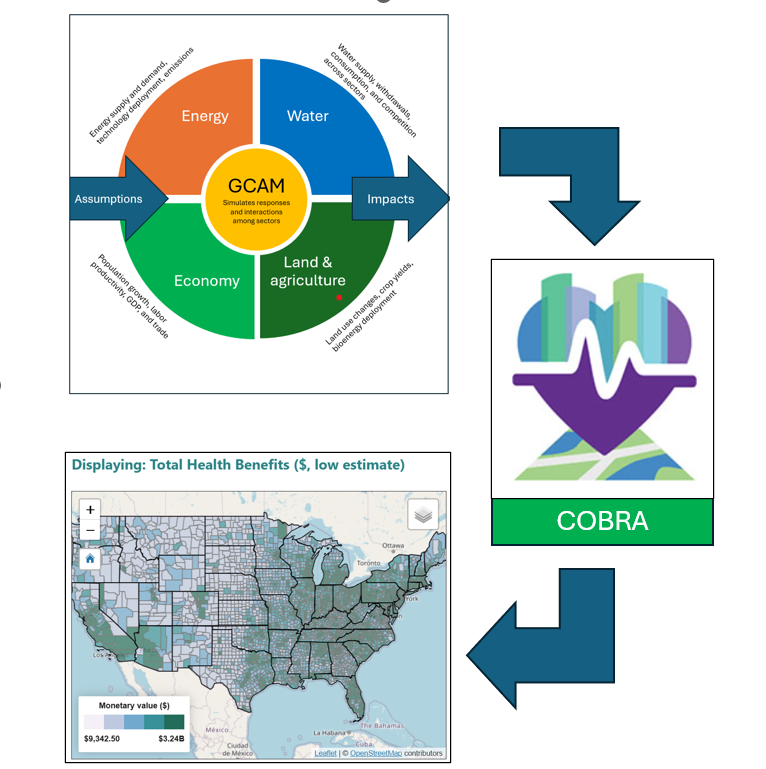Announcement:
GLIMPSE-CE (Community Edition) v1.0-beta has been released on GitHub!
https://github.com/DLoughlin/GLIMPSE-CE
Mission statement
Smarter planning through simulating the impacts of decisions - Empowering decision‑makers with transparent, science‑driven modeling tools that turn complex data into actionable insights. By integrating energy, climate, air quality, and health outcomes, governments and organizations can plan smarter, act sooner, and create a cleaner, more sustainable future.
Explore our tools
-

GCAM
The Global Change Analysis Model (GCAM) is an open source human-Earth systems model. GCAM was developed by the Joint Global Change Research Institute (a collaboration between the Univ. of Maryland and Pacific Northwest National Laboratory). GCAM simulates the co-evolution of the economic, energy, water, and land use systems, estimating impacts on fuel use, fuel prices, emissions, and climate. GCAM-USA produces results at the state level. For more information about GCAM and GCAM-USA, including documentation, please see the GCAM GitHub site: https://github.com/JGCRI/gcam-core.
-

GLIMPSE
The GCAM Long-term Interactive Multi-Pollutant Scenario Evaluator (GLIMPSE) is an open source graphical user interface for the GCAM model. GLIMPSE facilitates tasks such as policy implementation, scenario development, model execution and debugging, quality assurance, and results visualization and analysis. GLIMPSE was originally developed by the U.S. EPA where En2MG’s Dan Loughlin was the lead developer. More information about EPA’s version of GLIMPSE can be found here: https://github.com/USEPA/GLIMPSE.
-

Other tools
GCAM results can be translated into the inputs for other modeling tools. For example, a GCAM-to-COBRA crosswalk can be used with EPA’s CO-Benefits Risk Assessment (COBRA) tool to estimate the air quality and health impacts of energy futures in the United States. GCAM has also been linked with full-scale air quality models such as the Community Multiscale Air Quality (CMAQ) model, as well as used to develop the internally-consistent scenarios for other uses, including life cycle analysis and assessment of the impacts of autonomous vehicles.
Explore our services
-
Training
Provide trainings for GLIMPSE and GCAM. Typical content includes the following: background on integrated assessment modeling, setting up and using GLIMPSE, scenario design and implementation, how GCAM works, and interpreting and communicating results. Format can be in-person or virtual.
-
Technical support
Assist GLIMPSE and GCAM users, including through supporting scenario design and implementation, debugging, and visualization and interpretation of results.
-
GLIMPSE development
Modify and improve GLIMPSE to meet client needs. Examples include adding support for additional types of policies, constructing an interface for adding new and emerging technologies, and integrating new visualization and analysis tools.
-
Applications
Conduct or collaborate on analyses, including applications such as technology assessment, identification of cost-effective and robust management strategies, and translating alternative energy futures into air quality and health impacts.
Examples projects and applications
Here is a selection of prior research activities highlighting Em2MG capabilities and collaborations:
Assessing the air pollutant and health co-benefits associated with deep decarbonization:
Shankar, U., Murphy, B., Weber, M., Ou, Y., Smith, S., Loughlin, D., and C. Nolte (2025). Modeling the air quality impacts of future energy scenarios. ACE ES&T Air, Oct. 2025. https://doi.org/10.1021/acsestair.5c00175. This study demonstrates a methodology for translating the air pollutant emission projections of the GCAM human-Earth systems model into the inputs needed by a full-scale chemical transport model, CMAQ, to evaluate resulting air quality. The methodology is applied to examine the air quality implications of achieving a deep decarbonization target. The results suggest widespread benefits, but point to the potential need to manage particulate matter emissions from wood heating and bioenergy.
Loughlin, D., Barron, A., Basnet Chettri, et al. (2024). Health and air pollutant emission impacts of Net Zero CO2 by 2050 scenarios from the Energy Modeling Forum 37 study. Energy and Climate Change, 5(2024), 100165. https://doi.org/10.1016/j.egycc.2024.100165. This study examines the air pollutant emissions projections for six Integrated Assessment Models (IAMs), both with and without a Net Zero CO2 target. While the study finds that the projections are notably different across models, these differences are largely explainable based upon model scope, structure, and assumptions. Furthermore, despite these differences, the Net Zero target consistently resulted in significantly reduced air pollutant emissions across all the models. The EPA’s CO-Benefits Risk Assessment (COBRA) tool was applied to emission results of three models. This screening tool suggested that there would be widespread air quality and health benefits across the U.S. when targeting deep decarbonization.
Ou, Y., Iyer, G., McJeon, H., Cui, R., Zhao, A., O’Keefe, K.T.V., Zhao, M., Qiu, Y., and D.H. Loughlin (2023). State-level energy-water-land-health analysis of the US net-zero emissions goal. Energy and Climate Change, Oct. https://doi.org/10.1016/j.egycc.2023.100117. This study demonstrates the ability of the GCAM-USA human-Earth systems model to inform the quantification of energy, water, land, and health impacts of alternative pathways for achieving a Net-Zero CO2 goal. Findings include significant capital turnover and stranded assets, reduced demand fo rwater withdrawals, expanded forest land, and large air quality-related health benefits.
Understanding the air pollutant and greenhouse gas impacts of new and emerging energy technologies:
Ou, Y., Kittner, N., Smith, S.J., Babaee, S., Nolte, C.G., and D.H. Loughlin (2021). Evaluating long-term emission impacts of large-scale electric vehicle deployment in the US using a human-earth systems model. Applied Energy, 300(2021), 117364. https://doi.org/10.1016/j.apenergy.2021.117364. This study suggests that significant air pollutant emission reductions can be achieved through electrification of the U.S. onroad light-duty fleet. The study also highlights modeled outputs, such as price-induced fuel switching in other sectors and caveats these by discussing the model’s limited representations of refining and other industries. Recommendations are made for model improvements to address questions surrounding vehicle electrification more fully.
Sadavarte, P., Shindell, D., and D.H. Loughlin (2025). Comparing the climate and air pollution footprints of Lithium-ion battery-based EVs and ICEs in the US incorporating systemic energy system responses. PLOS Clim 4(10): e0000714. https://doi.org/10.1371/journal.pclm.0000714. In this manuscript, we include life-cycle emissions within an integrated assessment framework, suggesting that electric vehicles have fewer net GHG emissions compared to conventional vehicles after only several years of operation.
Incorporating energy efficiency, renewable energy, and fuel switching into air quality management strategies:
Loughlin, D.H., Macpherson, A.J., Kaufman, K.R., and B.N. Keaveny (2017). Marginal abatement cost curves for NOx that incorporate control measures, renewable energy, energy efficiency and fuel switching. Journal of the Air and Waste Management Assoc., 67(10), 1115-1125. DOI: https://doi.org/10.1080/10962247.2017.1342715. Efforts to calculate the costs and benefits of reducing air pollutant emissions have typically focused on “end-of-pipe” controls that remove those emissions from exhaust gases. “Nontraditional” control measures are also available, including energy efficiency, renewable energy, and fuel switching to lower- or zero-carbon fuels. These controls are difficult to consider in a cost-benefit analysis because their cost-effectiveness (e.g., $/ton of pollutant removed) is not straightforward to calculate. In this study, we use the MARKAL energy system model to develop marginal abatement cost curves for nitrogen oxide (NOx) emissions. The curves indicate strategies for achieving specific emissions reductions through cost-effective combinations of end-of-pipe and non-traditional controls.
Innovative approaches for developing air quality management strategies:
Ou Y., West, J.J., Smith, S.J., Nolte, C.G., and D.H. Loughlin (2020). Air pollution control strategies directly limiting national health damages in the US. Nature Communications, (2020)11:957, https://doi.org/10.1038/s41467-020-14783-2. In developing air pollution control strategies, one approach is to iterate over a small set of potential emission reduction level (often 2 to 3), using air quality modeling to determine the air pollution levels associated with each. Based on the results, an emission reduction target to achieve an air pollution goal is estimated. Controls are then chosen to achieve the targeted reductions. This approach is practicable, but can be time consuming. Furthermore, the complexities of pollutant chemistry and transport may result in the controls under- or over-shooting the air quality target. Here we demonstrate an alternative in which health impact factors are integrated directly into the GCAM-USA human-Earth systems model. GCAM-USA is then used to automate the process of finding emission control strategies that meet a health benefit target. In selecting a control strategy, GCAM-USA simultaneously considers the cost-effectiveness of both tradtional and non-tradition controls, considering options across all sectors of the economy. In this study, we demonstrate the use of this novel approach to identify state-specific strategies for reducing the mortality costs associated with fine particulate matter.
Babaee, S., Loughlin, D.H., and P.O. Kaplan (2020). Incorporating upstream emissions into electric sector nitrogen oxide reduction targets. Cleaner Engineering and Technology, https://doi.org/10.1016/j.clet.2020.100017. In designing power sector emission control requirements, one option would be to provide utilities with credits for reducing upstream emissions, such as from coal mining and natural gas extraction. In this analysis, compared the performance of (i) a cap on power sector NOx emissions, and (ii) a cap included both power sector and upstream emissions. The caps were designed to achieve the same overall NOx reductions. While modeling the latter approach resulted in lower control cost, it also had a disbenefit: increases in emissions of other pollutants, including particulate matter (PM) and sulfur dioxide (SO2). This result was because the additional flexibility allowed some of the older, higher PM- and SO2-emitting power plants to remain in service. This study provides valuable insights about the tradeoffs between cost and flexibility, as well as the need for careful policy design to avoid unintended consequences.
Our story (so far)…
The Energy & Environmental Modeling Group, LLC (En2MG), was founded in 2025 by Dan Loughlin, Ph.D. Dan was previously an environmental scientist for more than two decades within the U.S. EPA’s Office of Research and Development, where he contributed to the Global Change Air Quality Assessment and to two National Climate Assessments. Dan is also an Adjunct Professor in the Earth and Climate Sciences Division of Duke University’s Nicholas School of the Environment and holds adjunct and graduate faculty appointments at N.C. State University and the Univ. of North Carolina at Chapel Hill, respectively. Dan’s publications can be found on his Google Scholar page (link).
Throughout his career, Dan’s primary focus has been developing strategies for improving air quality and reducing greenhouse gas emissions. Around 2010, he began to work with the Global Change Analysis Model (GCAM). A presentation at an Annual GCAM Community Modelers’ Meeting had a major impact on his work. The Univ. of MD’s Fernando Miralles-Wilhelm presented a set of real world examples involving major environmental management decisions. For each, he illustrated how the decisions would have been different - and better - if GCAM had been used. He stated: “Decisions are being made every day that would benefit from the models and tools that we are developing” and challenged the audience to get our models and insights out into the real world where they could positively impact decisions.
This challenge played a large part in motivating Dan’s efforts to develop the GLIMPSE software. GLIMPSE (GCAM Long-term Interactive Multi-Pollutant Scenario Evaluator) is a decision support tool built around GCAM. While being a very powerful model, GCAM has a steep learning curve, limiting the number of users and applications. In working with GCAM, Dan found that many complex tasks could be automated or enhanced through a graphical user interface, greatly reducing the learning curve. GLIMPSE now helps decision makers and analysts conduct activities such as: (i) developing an inventory of greenhouse gas and air pollutant emissions, (ii) projecting that inventory into the future for specific scenarios, and (iii) and developing cost-effective and robust strategies for achieving energy, climate, and environmental goals. GLIMPSE also facilitates visualization and interpretation of results, repeatability, and debugging, while also supporting many existing GCAM workflows.
Dan led the effort to make GLIMPSE open source and public domain, and users now include researchers and analysts at universities, federal and state governments, non-profits, consulting firms, and financial firms. En2MG seeks to continue that work - improving coordinated energy and environmental decision making at the state, regional, and national scales.
Our values
Scientific Integrity — Grounded in transparent, peer‑reviewed methods
Collaboration — Co‑creating solutions with clients and partners
Open Science — Championing open‑source tools and reproducible workflows
Contact
Interested in working with En2MG? Fill out some info and we will be in touch shortly. We can’t wait to hear from you!

